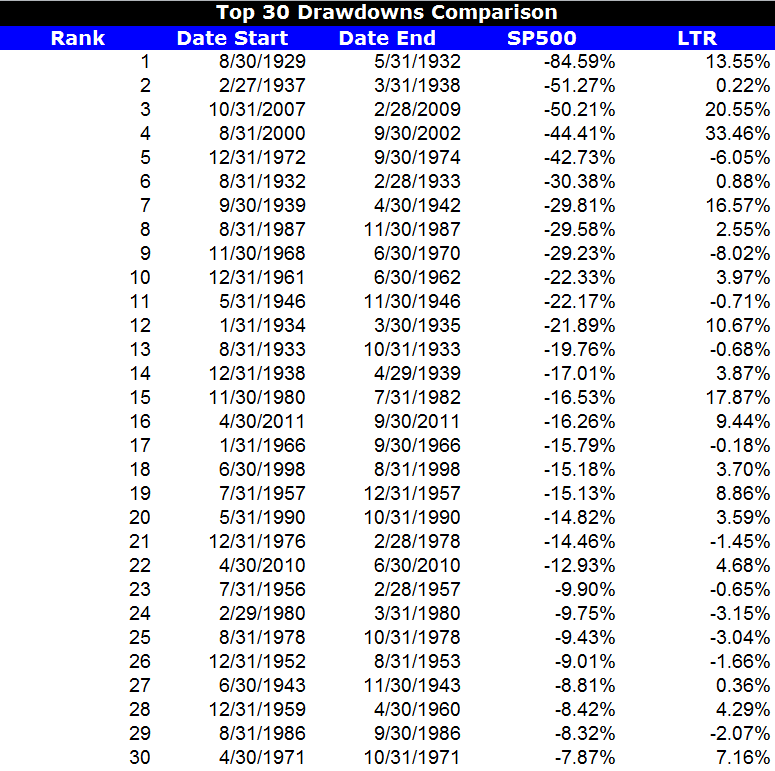As “everyone” seems to know, the US 10-year Treasury bond has a low relative yield and is “inevitably going to rise at some point in the future.”
We have no strong feelings one way or the other on the US Treasury. We simply aren’t smart (or perhaps arrogant) enough to make a strong call. We see compelling stories from smart folks saying it is a great investment and from smart folks saying it is a terrible investment.
But who really knows?
And while we don’t have a strong opinion on the future of bonds as a stand-alone asset class, we do have an ability to test how long-bonds can serve a portfolio.
The results below highlight the top 30 drawdowns in the S&P 500 Total Return Index from 1927 to 2013. Next to the S&P 500 return is the corresponding total return on the 10-Year (LTR) over the same drawdown period:

The results are hypothetical results and are NOT an indicator of future results and do NOT represent returns that any investor actually attained. Indexes are unmanaged, do not reflect management or trading fees, and one cannot invest directly in an index. Additional information regarding the construction of these results is available upon request.
Long bonds are clearly interesting in a portfolio context. In addition to providing a real return, plus an expected inflation return, the asset serves as a quasi-insurance policy: When stock markets blow up, US long bonds do well, on average.
The resilience of this finding is remarkable. In the context of a traditional asset pricing model, such as the Capital Asset Pricing Model (CAPM), an asset that actually delivers returns when the rest of the world is blowing up (I.e., negative beta during treacherous times), should have a negative expected return because of the diversification benefits. But with US Treasury Bonds, we actually earn a positive expected return AND get the insurance benefit. One might even consider the US Treasury bond “anomalous.”
Of course, the hidden insurance benefit associated with US Treasury Bonds hinges on the assumption that the US will maintain its status as the king of the hill. When the world goes south, and everyone wants a stable asset, the US Treasury Bond is the only game in town.
There are many reasons why the US could lose its standing. But there are even more reasons why the US, while not perfect, is still light-years ahead of the competition. With 50+ year edges in education/research infrastructure, entrepreneurial culture, dominant military, endowed location, and so forth, we should continue to win the Tallest Man Award in the midget contest for the foreseeable future.
But things can–and do–change.
Happy New Year and Go America!
About the Author: Wesley Gray, PhD
—
Important Disclosures
For informational and educational purposes only and should not be construed as specific investment, accounting, legal, or tax advice. Certain information is deemed to be reliable, but its accuracy and completeness cannot be guaranteed. Third party information may become outdated or otherwise superseded without notice. Neither the Securities and Exchange Commission (SEC) nor any other federal or state agency has approved, determined the accuracy, or confirmed the adequacy of this article.
The views and opinions expressed herein are those of the author and do not necessarily reflect the views of Alpha Architect, its affiliates or its employees. Our full disclosures are available here. Definitions of common statistics used in our analysis are available here (towards the bottom).
Join thousands of other readers and subscribe to our blog.

